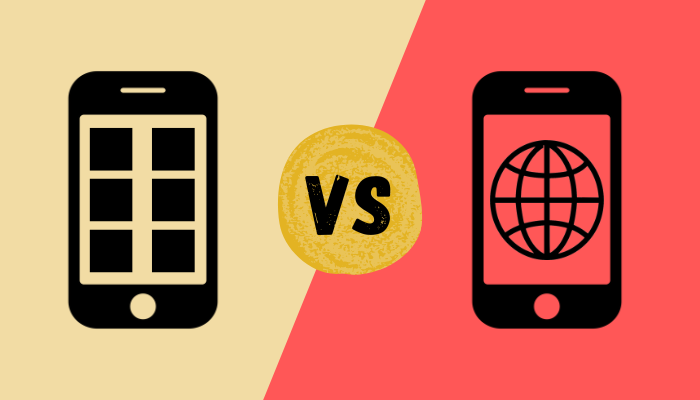Difference between Mobile and Web app testing
 Abhay
Abhay
Before exploring the contrast between web and mobile app testing, let us understand why a comparison is needed.
During this time, mobile devices were not too significant for fundamental communication. However, the explosive growth of mobile devices in the last decade has changed digital topography. There are 3.8 billion smartphone users worldwide. This promotes the use of apps and mobile testing platforms. Software testing typically is testing web- applications for PC.
Growth in mobile usage To capitalize on the expansive usage of smartphones, enterprises began developing mobile applications. This increase in the market of mobile phones with distinct configurations requires testing of mobile apps across multiple devices, preferably mobile app test automation practices. To give optimal experiences to users across mobile devices, teams optimize their apps.
Developers update their apps for the legacy and the latest Android and iOS versions. Also, the fragmentation effect in the mobile environment is directed to the high demand for mobile testing. For companies to meet this demand, enterprises are beginning to integrate mobile testing and web app testing as part of their overall testing strategy.
The Difference Between Web and Mobile Applications
Web Applications
Web applications are software applications that dwell on web servers. They are developed employing popular technologies like HTML, CSS, and JavaScript. These are opened and accessed using different web browsers like Chrome, Safari, and Firefox.
Well-optimized web applications can be viewed from multiple devices like tablets, mobiles, and desktops furnished with active internet connections.
Mobile Applications
Mobile applications are those apps specially developed for running on mobile devices. At a high footing, mobile apps are classified into three categories:
Mobile web applications are principally standard web apps that can be accessed through mobile browsers. These web apps may be developed in a way that they resemble mobile apps, but they vary significantly. Browser testing is extensively used to validate web apps across thousands of available browsers.
Native applications are platform-specific apps that users can install from specific app stores such as App Store or Google Play Store. They are designed using different programming languages for unique operating systems like iOS or Android. These applications are expensive and highly effort-intensive as developers have to maintain different codebases for other mobile OS. For instance, native iOS apps are penned in Objective-C, whereas Java is used to write native Android apps.
Hybrid applications are designed by combining the characteristics of native and web apps. These operations are constructed using a standard web stack like HTML, CSS, and Javascript. and are bound in a native ambient using several frameworks.
Check out: Fundamentals of Test Harness
The difference between mobile and web testing
Although the testing tools and techniques applied for both differ significantly, some tests are similar for both forms of testing:
Functional tests
Performance tests
Usability tests
Compatibility tests
Localization tests
Here are the ways the testing terrain differs in mobile app and web app testing.
Web application testing aims to assure that websites deliver an operational, bug-free experience across different browsers and devices. On the contrary, mobile testing seeks to pinpoint the compatibility issues or errors for the given mobile app across other Android and iOS smartphones. The QA teams must choose the precise set of tools that empowers them to accomplish quicker and more effective testing with the maximum possible test coverage.
Tools used for web application testing
Web app testing aims to roll out applications that provide a gleaming user experience across numerous browsers. It also assures that web-applications hold on to ideally perform when opened from non-identical platforms.
Although several commercial tools are available for web application testing, Selenium has been the tool suite of choice amongst the QA community for many years. QA teams can perform automated website UI testing in popular web browsers like Safari, Mozilla Firefox, and Google Chrome using this tool. Also, QA teams can run parallel testings across desired ambients using a Selenium Grid.
A vital reason for Selenium gaining high popularity is that it is compatible with several programming languages, which makes it a very convenient tool for the QA teams to design test cases.
Tools used for Mobile App Testing
As mentioned ahead, the mobile app ecosystem is complex for testing as there are different types of apps. Before testing mobile apps, QA teams should identify whether the app to be tested is the hybrid, native, or mobile web.
Popular tools that run automated tests for hybrid, native, and mobile web apps are listed below.
Appium
Appium is a famous open-source framework for testing native, hybrid, and mobile web apps. It is based on Selenium and provides mobile app test automation. This tool is used to automate test scripts for Android and iOS apps on bona fide mobile devices, emulators, and simulators. QA teams require to produce separate test scripts for Android and iOS. Appium also allows QAs to elect the programming language to work.Espresso
Espresso is a native open-source mobile testing platform developed by Google, designed especially for automated UI testing of Android applications. It forms a component of the Android SDK. It is implemented for native mobile app development and testing. Intuitive API and spontaneous synchronization are a couple of vital benefits this framework offers. Java and Kotlin are used to write Expresso test scripts.XCUITest
XCUITest is a UI testing tool bundled along with the XCode IDE. It allows QA teams to automate mobile UI tests for native iOS apps and is known for its high reliability. Objective-C or Swift can only be used to write XCUITest.
Conclusion
Over the most common types of testing, several criteria are often overlooked. However, these are unique to every mobile app testing, such as the internet connection and battery. The main objective of testing an app is to assure its proper functioning and usability under various conditions. Automated testing tools optimize your testing efforts and reduce them while making the entire quality assurance process thorough and cost-efficient. The framework or platform should be chosen wisely according to the type of testing performed.
Selenium, when coupled with integrated tools, can cover web application testing. However, there are many choices of tools and frameworks when it comes to testing mobile apps. You need to reckon the type of your application, its platform, and other vital criteria before preferring one of them for your mobile testing.
Original source: This post was originally published on https://marketbusinessnews.com/difference-between-mobile-and-web-app-testing/319545/
Subscribe to my newsletter
Read articles from Abhay directly inside your inbox. Subscribe to the newsletter, and don't miss out.
Written by

Abhay
Abhay
I am a digital marketer with 13+ yrs. experience. I have written so many blogs and also have sound knowledge in software testing.